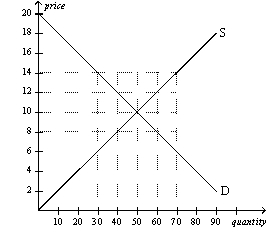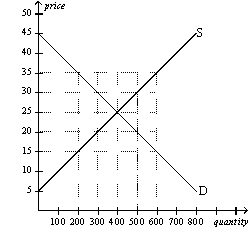A) can cause a movement along a supply curve.
B) can affect future supply,but not today's supply.
C) can affect today's supply.
D) cannot affect either today's supply or future supply.
Correct Answer

verified
Correct Answer
verified
Multiple Choice
A leftward shift of a demand curve is called
A) an increase in demand.
B) a decrease in demand.
C) a decrease in quantity demanded.
D) an increase in quantity demanded.
Correct Answer

verified
Correct Answer
verified
True/False
In a perfectly competitive market,buyers and sellers are price setters.
Correct Answer

verified
Correct Answer
verified
Multiple Choice
Table 4-4
 -Refer to Table 4-4.If these are the only four sellers in the market,then the market quantity supplied at a price of $4 is
-Refer to Table 4-4.If these are the only four sellers in the market,then the market quantity supplied at a price of $4 is
A) 4 units.
B) 5 units.
C) 20 units.
D) 80 units.
Correct Answer

verified
Correct Answer
verified
Multiple Choice
Which of the following is a determinant of the market supply curve but not a determinant of an individual seller's supply?
A) technology
B) expectations
C) input prices
D) the number of sellers
Correct Answer

verified
Correct Answer
verified
True/False
The quantity demanded of a product is the amount that buyers are willing and able to purchase at a particular price.
Correct Answer

verified
Correct Answer
verified
Multiple Choice
In a competitive market,the quantity of a product produced and the price of the product are determined by
A) a single buyer.
B) a single seller.
C) one buyer and one seller working together.
D) all buyers and all sellers.
Correct Answer

verified
Correct Answer
verified
Multiple Choice
What will happen in the rice market now if buyers expect higher rice prices in the near future?
A) The demand for rice will increase.
B) The demand for rice will decrease.
C) The demand for rice will be unaffected.
D) The supply of rice will increase.
Correct Answer

verified
Correct Answer
verified
Multiple Choice
Table 4-7
The demand schedule below pertains to sandwiches demanded per week.
 -Refer to Table 4-7.Regarding Charlie and Maxine,whose demand for sandwiches conforms to the law of demand?
-Refer to Table 4-7.Regarding Charlie and Maxine,whose demand for sandwiches conforms to the law of demand?
A) only Charlie's
B) only Maxine's
C) both Charlie's and Maxine's
D) neither Charlie's nor Maxine's
Correct Answer

verified
Correct Answer
verified
Multiple Choice
Buyers are able to buy all they want to buy and sellers are able to sell all they want to sell
A) at prices at and above the equilibrium price.
B) at prices at and below the equilibrium price.
C) at prices above and below the equilibrium price,but not at the equilibrium price.
D) at the equilibrium price,but not above or below the equilibrium price.
Correct Answer

verified
Correct Answer
verified
Multiple Choice
Figure 4-9  -Refer to Figure 4-9.If there is currently a shortage of 20 units of the good,then
-Refer to Figure 4-9.If there is currently a shortage of 20 units of the good,then
A) the law of demand predicts that the price will rise by $2 to eliminate the shortage.
B) the law of supply predicts that the price will rise by $2 to eliminate the shortage.
C) the law of supply and demand predicts that the price will rise by $2 to eliminate the shortage.
D) the law of supply and demand predicts that the price will fall by $2 to eliminate the shortage.
Correct Answer

verified
Correct Answer
verified
Multiple Choice
The forces that make market economies work are
A) work and leisure.
B) politics and religion.
C) supply and demand.
D) taxes and government spending.
Correct Answer

verified
Correct Answer
verified
True/False
When the market price is below the equilibrium price,the quantity of the good demanded exceeds the quantity supplied.
Correct Answer

verified
Correct Answer
verified
Multiple Choice
What will happen to the equilibrium price and quantity of traditional camera film if traditional cameras become more expensive,digital cameras become cheaper,the cost of the resources needed to manufacture traditional film falls,and more firms decide to manufacture traditional film?
A) Price will fall and the effect on quantity is ambiguous.
B) Price will rise and the effect on quantity is ambiguous.
C) Quantity will fall and the effect on price is ambiguous.
D) Quantity will rise and the effect on price is ambiguous.
Correct Answer

verified
Correct Answer
verified
Multiple Choice
A movement downward and to the right along a demand curve is called
A) an increase in demand.
B) a decrease in demand.
C) a decrease in quantity demanded.
D) an increase in quantity demanded.
Correct Answer

verified
Correct Answer
verified
Multiple Choice
A demand schedule is a table that shows the relationship between
A) quantity demanded and quantity supplied.
B) income and quantity demanded.
C) price and quantity demanded.
D) price and income.
Correct Answer

verified
Correct Answer
verified
Multiple Choice
Figure 4-8  -Refer to Figure 4-8.At a price of $20,
-Refer to Figure 4-8.At a price of $20,
A) there would be a shortage and the law of supply and demand predicts that the price will fall from $20 to a lower price.
B) there would be a surplus and the law of supply and demand predicts that the price will rise from $20 to a higher price.
C) there would be an excess demand and the law of supply and demand predicts that the price will rise from $20 to a higher price.
D) there would be an excess supply and the law of supply and demand predicts that the price will fall from $20 to a lower price.
Correct Answer

verified
Correct Answer
verified
Multiple Choice
A market demand curve shows
A) the relationship between price and the number of buyers in a market.
B) how quantity demanded changes when the number of buyers changes.
C) the sum of all prices that individual buyers are willing and able to pay for each possible quantity of the good.
D) how much of a good all buyers are willing and able to buy at each possible price.
Correct Answer

verified
Correct Answer
verified
True/False
Whenever a determinant of supply other than price changes,the supply curve shifts.
Correct Answer

verified
Correct Answer
verified
Multiple Choice
A leftward shift of a supply curve is called
A) an increase in supply.
B) a decrease in supply.
C) a decrease in quantity supplied.
D) an increase in quantity supplied.
Correct Answer

verified
Correct Answer
verified
Showing 441 - 460 of 467
Related Exams